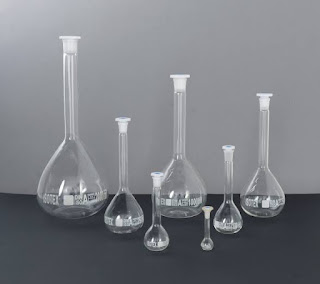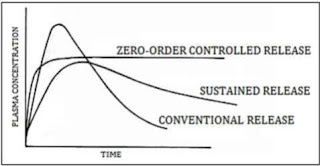Medicinal chemistry-1
How blood glucose level is maintained normally in fasting state ?
Ans:
1. Reduction
of Uptake of glucose by less vital tissues
Due to low insulin level, glucose
uptake by muscle and adipose tissue is reduced due to inhibition of
glut-4-transporter
2. Stimulation
of glycogenolysis
Glucagon through its receptors in
liver cells activates phosphorylase enzyme through cyclic AMP.
3.Stimulation
of gluconeogenesis
Glucagon
stimulates gluconeogenesis from amino acids through alanine- glucose cycle
Lactate forms glucose in liver through Cori cycle - Lactate-glucose cycle.
Epinephrine
promotes glycogenolysis in muscle and on catabolism, lactate produced is
carried to liver for gluconeogenesis
What is the Difference Between Catabolism and Anabolism?
|
Difference Between
Catabolism and Anabolism |
|
|
Catabolism breaks down
big complex molecules into smaller, easier to absorb molecules. |
Anabolism builds
molecules required for the body’s functionality. |
|
The process of
catabolism releases energy. |
Anabolic
processes require energy. |
|
Hormones involved in
the processes are adrenaline, cytokine, glucagon, and cortisol. |
Hormones involved in
the process are estrogen, testosterone, growth hormones and insulin. |
|
Examples of catabolic
processes are proteins becoming amino acids, glycogen breaking down into
glucose and triglycerides breaking up into fatty acids. |
Examples include the
formation of polypeptides from amino acids, glucose forming glycogen and
fatty acids forming triglycerides. |
|
In catabolism,
potential energy is changed into kinetic energy. |
In anabolism, kinetic
energy is converted into potential energy. |
|
It is required to
perform different activities in living entities. |
It is required for
maintenance, growth, and storage. |
How blood glucose is
brought down to normal level in fed state?
By transport of glucose
into the cells
Glut-2 transporter in liver is
freely permeable to glucose. Insulin increases the transport of glucose across
cell membranes of adipose tissue and muscle by stimulating glut-4-transporter.
Stimulation of
glycolysis
In liver, insulin increases the
glycolysis by inducing the synthesis of the following enzymes
ü Glucokinase
ü Phosphofructokinase-1
ü Pyruvate
kinase
Stimulation of
glycogenesis
In liver and muscle, insulin
stimulates glycogenesis by activating glycogen synthase through
dephosphorylation of the enzyme.
Stimulation of
lipogenesis
Insulin stimulates the acetyl-CoA-
carboxylase, the rate limiting enzyme in fatty acid synthesis mainly in liver,
and to a lesser extent in adipose tissue.
Stimulation of protein
synthesis
Insulin increases protein
synthesis.
What
is the main principle of Carbohydrates?
Carbohydrates
are vital to your health for many reasons.Such as:
Providing
energy
Carbohydrates are the body's main
fuel source. During digestion, sugars and starches are broken down into simple
sugars. They're then absorbed into the bloodstream, where they're known as
blood sugar (blood glucose).
From there, glucose enters the
body's cells with the help of insulin. Glucose is used by the body for energy.
Glucose fuels your activities — whether it's going for a jog or simply
breathing and thinking. Extra glucose is stored in the liver, muscles and other
cells for later use. Or extra glucose is converted to fat.
Protecting against
disease
Some evidence suggests that whole
grains and dietary fiber from whole foods help lower your risk of heart disease
and stroke. Fiber may also protect against obesity, colon and rectal cancers,
and type 2 diabetes. Fiber is also essential for optimal digestive health.
Controlling weight
Evidence shows that eating plenty
of fruit, vegetables and whole grains can help you control your weight. Their
bulk and fiber content aids weight control by helping you feel full on fewer
calories. Despite what proponents of low-carb diets claim, few studies show
that a diet rich in healthy carbs leads to weight gain or obesity.
How
to make healthy carbohydrates work in a balanced diet?
1. Focus on eating fiber-rich fruits and vegetables
2. Choose whole grains
3. Stick to low-fat dairy products
4. Eat more beans, peas and lentils.
5. Limit added sugars.
What
causes deficiency of carbohydrates?
Carbohydrates are degraded into
sugar which, as a primary energy source, is required for the brain, muscles and
other parts of the human body to function normally. When you don't get enough
carbohydrates, the level of sugar in your blood may drop to below the normal
range (70-99 mg/dL), causing hypoglycemia. Hypoglycemia
kills the patient immediately whereas hyperglycemia kills slowly by producing
complications and organ failure So it is essential to maintain blood glucose at
optimum level.
Classify
the Carbohydrates.
How
do you convert a 3-carbon carbohydrate to a 4-carbon carbohydrate?
Using Killiany-Fisher synthesis I can easily convert a 3-carbon carbohydrate to a 4-carbon carbohydrate.
The Kiliani–Fischer synthesis lengthens the
carbon chain of carbohydrates by adding one carbon to the aldehyde group of an
aldose. It is
organized in 2 steps.such as:
How
do you convert a 6-carbon carbohydrate to a 5-carbon carbohydrate?
Using Ruff degradation I can easily convert a 3-carbon carbohydrate to a 4-carbon carbohydrate. Ruff degradation is a reaction used to shorten the open chain forms of monosaccharides. It is functionally the reverse reaction of Kiliani-Fischer synthesis.
It is organized in 2 steps.such as:
What
is Glycolysis? Discuss about it.
Glycolysis
is the metabolic pathway that
converts glucose C6H12O6, into pyruvate.The
free energy released in this process is used to form the high-energy molecules and
NADH.
It is organized in 10 steps.such as:
Step-1: Hexokinase
The first step in glycolysis is the
conversion of D-glucose into glucose-6-phosphate. The enzyme that catalyzes
this reaction is hexokinase.
Step 2: Phosphoglucose
Isomerase
The second reaction of glycolysis
is the rearrangement of glucose 6-phosphate (G6P) into fructose 6-phosphate
(F6P) by glucose phosphate isomerase (Phosphoglucose Isomerase).
Step 3:
Phosphofructokinase
Phosphofructokinase, with magnesium
as a cofactor, changes fructose 6-phosphate into fructose 1,6-bisphosphate.
Step 4: Aldolase
The enzyme Aldolase splits fructose
1, 6-bisphosphate into two sugars that are isomers of each other. These two
sugars are dihydroxyacetone phosphate (DHAP) and glyceraldehyde
3-phosphate (GAP).
Step 5: Triosphosphate
isomerase
The enzyme triosephosphate
isomerase rapidly inter- converts the molecules dihydroxyacetone phosphate
(DHAP) and glyceraldehyde 3-phosphate (GAP). Glyceraldehyde phosphate is
removed / used in next step of Glycolysis.
Step 6:
Glyceraldehyde-3-phosphate Dehydrogenase
Glyceraldehyde-3-phosphate
dehydrogenase (GAPDH) dehydrogenates and adds an inorganic phosphate to
glyceraldehyde 3-phosphate, producing 1,3 bisphosphoglycerate.
Step 7:
Phosphoglycerate Kinase
Phosphoglycerate kinase transfers a
phosphate group from 1,3-bisphosphoglycerate to ADP to form ATP and
3-phosphoglycerate.
Step 8:
Phosphoglycerate Mutase
Step 9: Enolase
The
enzyme enolase removes a molecule
of water from 2-phosphoglycerate to form phosphoenolpyruvic acid (PEP).
Step 10: Pyruvate
Kinase
The enzyme pyruvate kinase transfers
a P from phosphoenolpyruvate (PEP) to
ADP to form pyruvic acid and ATP


















Comments
Post a Comment
Thanks